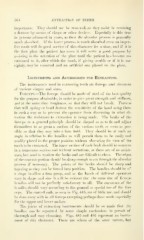Page 566 - My FlipBook
P. 566
564 EXTRACTION OF TEETH.
iniportanoo. Thev slumld not bo removod, as they assist in retaining
a (Icntuiv l)V means of clasps or other devices. Especially is this true
in persons adxanccd in years, as then the alveolar process is generally
much absorbed. It' the lower pro(;ess is much absorbed even an imper-
fect tooth will do good service of this character for a time, and if it is
the first plat(! the patient has worn it will serve a good purpose by
assisting in the retention of the plate until the patient has become ac-
customed to it, after which the tooth, if giving trouble or if it is un-
sightly, may be removed and an artificial one placed on the plate.
Instruments and Accessories for Extracting.
The instruments used in extracting teeth are forceps and elevators
of various shapes and sizes.
Forceps.—The forceps should be made of steel of the best quality
for the purpose obtainable, in order to give great strength and stiifness,
and at the same time toughness, so that they will not break. Forceps
that will spring or bend destroy the sensitivity of the hand using them
in such a Avay as to prevent the operator from discerning in what di-
rection the resistance to extraction is being made. The beaks of the
forceps as a general principle should be shaped so as to fit and adjust
themselves to as great a surface of the various teeth or roots as pos-
sible so that they may take a firm hold. They should be at such an
angle in relation to the handles as will permit them to be easily and
readily placed in the proper position without obscuring the view of the
tooth to be extracted. The inner surface of each beak should be concave
in a transverse section and without serrations, as these are of no assist-
ance, but tend to weaken the beaks and are difficult to clean. The edges
of the concave portion should be sharp enough to cut through the alveolar
process if necessary. The points of the beaks should be sharp and
tapering so they can be forced into position. The handles should be of
a shape to allow a firm grasp, and as the hands of different operators
vary in shape and size it will l)e evident that the same size of forceps
handles will not be perfectly satisfactory to all. The curvature of the
handles should vary according to the general or special use of the for-
ceps. The curved ends, as seen in Fig. 485, are of little use, and should
be done away with in all forceps excepting perhaps those made especially
for the up])er and lower molars.
The joints of extracting instruments should be so made that the
handles can be separated by some simple mechanism to permit of
thorough and easy cleansing. Figs. 485 and 486 represent an instru-
ment of this character. There are others of the same nature, but


